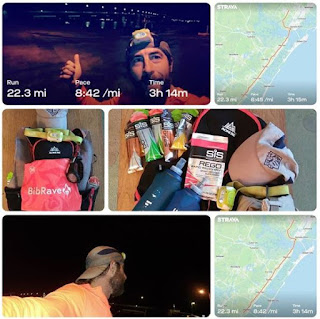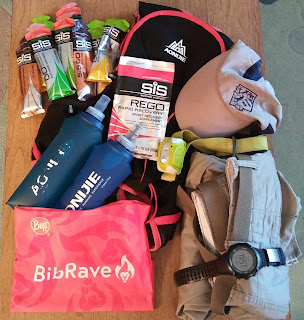Disclaimer: I received Science in Sport REGO Rapid Recovery to review as part of being a BibRave Pro. Learn more about becoming a BibRave Pro (ambassador), and check out BibRave.com to review, find, and write race reviews!
During the challenge:
I’m at the halfway point as I begin writing this report. I ran 22.36 miles from home to work this morning, just a bit shorter distance than what Google Maps had predicted (23 miles). I just ate lunch (a foot long turkey sub) and wanted to record some of my thoughts at this point. I feel good after refueling since this morning’s run and am eagerly waiting for the end of the workday so I can finish my round-trip commute. So far, the most difficult point for me was just getting started. I had trouble getting myself out of bed to begin with. I asked myself “why am I doing this? I’ve driven this route countless times; why run it?” It’s not a scenic route, it’s not an FKT attempt, and I usually don’t even like driving the route. Even with all this running through my head, I pushed myself out of bed and prepped for the first half of the run commute.
It’s been a few days since completing the 46ish mile round trip and I’ve had a chance to reflect on my why and just where I can find value in taking on such a task. The spontaneity of the idea for the challenge itself and the bit of unknown adventure it presented was one additional benefit I was able to tease out of this challenge. The idea for this was not my own, but my wife’s. It was the first weekend of November and we were having unseasonably warm weather, nearly 70 for a high and sunny all day, every day. I had taken a three day weekend and was itching to get a longer run in at some point before the following work week started. The Cape to Gate (from Cape May Point to Margate) 50 mile route had been on my radar for a while, and I told my wife I was thinking about giving it a shot which would require a ride either to the starting point or back home from the finishing point. Maybe she just didn’t feel like giving me a ride because she suggested the idea for me to run to and from work on Monday when the weather was forecasted to still be pretty nice. It would leave the weekend wide open for me to spend the time enjoying the weather with the family before the shorter cold and dreary fall/winter days set in. And with that, two days prior to the run, the idea was suggested and it was decided. As certain as I was at that point, I had no idea how much I would second guess my decision and have to force myself out of bed and then out the door come Monday morning.
Another value added benefit of this challenge I realized while running was that it was great mental preparation and a confidence booster for several multi day routes I’ve been considering trying. Since running the entire Batona Trail out and back as an FKT, I’ve been looking at other long routes and considering the many options of how to approach these routes that will most definitely be multi day efforts if/when attempted. Some of the routes that have gained my interest are primarily road routes. Having never run more than about 26 miles on roads in a single day, I’m not sure how my mind and body would acclimate to a stretch of multiple high mileage days all primarily on the shoulder of roads. If I planned a 3-5 day route all following roads, would I hate it and want to quit after the first day? I still can’t say for certain what the answer is, but this challenge helped give me a taste of what a multi day road route might be like.
With the running challenge complete, I can say it was far from the most enjoyable run or route that I’ve run. Of course, that is the opinion of someone who prefers trail running over road running. It served its purpose in providing a long run, a unique challenge by splitting it into a double, and an opportunity for me to practice quick recovery between back to back long runs. My recovery plan was pretty straightforward and began before I even finished the first half of the run. That part of the plan was to avoid becoming calorie depleted or dehydrated. I avoided both by simply drinking water and eating Science in Sport (SIS) gels for the first stretch of the day. Once I arrived at work I quickly refueled with SIS REGO Rapid Recovery post workout drink which contains a blend of carbohydrates, electrolytes, vitamins, soy protein, and nutrients. The individual serving packets were clutch for this and perfect for a run commute recovery. I then pretty much followed my normal routine for a work day which is pretty much staying on my feet all day at my stand up desk (Varidesk). Personally, I think that staying mobile and avoiding sitting helped keep my legs in better shape to run the second half of my commute. Apparently what I did for recovery and prep for the second leg of the challenge worked well for me. By the end of the work day I was looking forward to the run home and was able to maintain a slightly faster pace running home than to work. Maybe it had something to do with my headlamp batteries starting to weaken and my light beginning to fade, but I felt good at the pace I was running.
Upon my arrival home I was immediately greeted by my oldest son who loudly proclaimed to me and the rest of my family “Dad’s home! Challenge complete!” And that proclamation really drove the purpose for this run home to me. It was about finding a challenge that grabs your interest, makes you question whether it is a good or bad idea, and ultimately gives you a feeling of accomplishment when completed while teaching you something along the way. So what did I learn? I learned that not all challenges have to be epic adventures planned out far in advance, that you can create a challenge out of your daily commute. I was reminded again that mindset and personal drive make a difference as I wrestled with myself to get out the door in the morning. I was shown again that I don’t need a specific goal solidified with a set date to enjoy a tough training run. More or less, I was reminded that running is about the process, not what happens on race day.




















